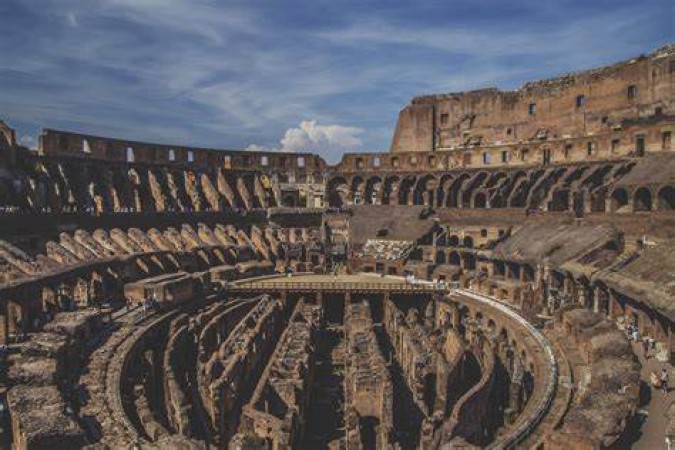
The Colosseum, an iconic symbol of ancient Roman engineering and entertainment, is an amphitheater of grand proportions located in the heart of Rome, Italy. This historical marvel has captivated the imagination of people worldwide, drawing millions of visitors each year. In this article, we delve into the fascinating history, architecture, and present-day significance of the Colosseum.
Historical Significance of the Colosseum
The Colosseum, also known as the Flavian Amphitheatre, holds great historical significance as it stands as a testament to the grandeur and opulence of the Roman Empire. Emperor Vespasian initiated its construction in AD 70, and it was completed in AD 80 by his successor and heir, Titus. The Colosseum was primarily used for hosting various public spectacles, including gladiatorial contests, animal hunts, and mock sea battles, all aimed at entertaining the masses and showcasing the Empire's power.
Architectural Marvel of the Colosseum
The Colosseum's architectural brilliance lies in its ingenious design and engineering prowess. The elliptical structure spans over 6 acres, standing approximately 50 meters tall, with a seating capacity of up to 80,000 spectators. The massive stone and concrete structure boasted advanced features like retractable awnings to shield the audience from the scorching sun and intricate underground tunnels for staging elaborate spectacles.
Location and Geography
General Location
The Colosseum is centrally situated in Rome, the capital of Italy, making it easily accessible to tourists and locals alike. Its strategic location ensured it served as a focal point for the city's social and political activities during the Roman Empire's heyday.
City of Rome
Rome, often referred to as the "Eternal City," boasts a rich history that spans over two and a half millennia. As the former capital of the Roman Empire, the city is brimming with ancient ruins, historic landmarks, and museums, making it a UNESCO World Heritage site.
Surrounding Landmarks
The Colosseum is surrounded by several other historically significant landmarks, including the Roman Forum, Palatine Hill, and the Arch of Constantine, adding to its allure for history enthusiasts and tourists.
Construction and Design
Amphitheater Features
The Colosseum's design incorporated impressive features that catered to the audience's comfort and enhanced the spectacles' visual impact. The seating arrangement was meticulously organized, with tiers designated for different classes of society, emphasizing the social hierarchy prevalent during that era.
Seating Arrangements
The seating hierarchy of the Colosseum began with the emperor and senators occupying the front rows, followed by equestrians, plebeians, and slaves arranged in ascending order.
Hypogeum
The Colosseum's hypogeum, a network of underground passages and chambers, served as a backstage area for performers and facilitated the movement of animals and props, surprising the audience during the spectacles.
Gladiators and Events
Gladiatorial Games
Perhaps the most infamous events held at the Colosseum were the gladiatorial games. These battles involved professional fighters, often slaves, condemned criminals, or prisoners of war, who fought to the death for the amusement of the crowd.
Other Spectacles and Events
Apart from gladiatorial contests, the Colosseum hosted various other spectacles, such as animal hunts, public executions, and reenactments of famous battles, all designed to enthrall the spectators.
Decline and Restoration
Fall of the Colosseum
With the fall of the Roman Empire, the Colosseum's popularity waned, and it suffered from neglect, pillaging, and natural disasters. The once-grand amphitheater fell into disrepair, and large portions of its marble facade were looted for other constructions.
Restoration Efforts
In recent centuries, there have been significant restoration efforts to preserve the Colosseum's structural integrity and cultural significance. Today, it stands as a poignant reminder of ancient Roman ingenuity and continues to inspire awe among visitors.
Colosseum Today
Tourist Attraction
As one of the most recognizable landmarks in the world, the Colosseum attracts tourists from all corners of the globe. Its historical and architectural significance make it a must-visit destination for history enthusiasts and anyone seeking a glimpse into the ancient past.
Preservation and Conservation
To ensure the Colosseum's continued existence for future generations, rigorous preservation and conservation efforts are ongoing. The monument's management actively monitors foot traffic and implements measures to protect its structural integrity.
The Colosseum remains a poignant symbol of Roman engineering prowess and the grandeur of ancient civilizations. Its historical significance and architectural brilliance continue to mesmerize visitors, offering a unique window into the past. Standing at the heart of Rome, this iconic amphitheater serves as a timeless testament to human creativity and the pursuit of entertainment.
Where is the Great Barrier Reef Located?